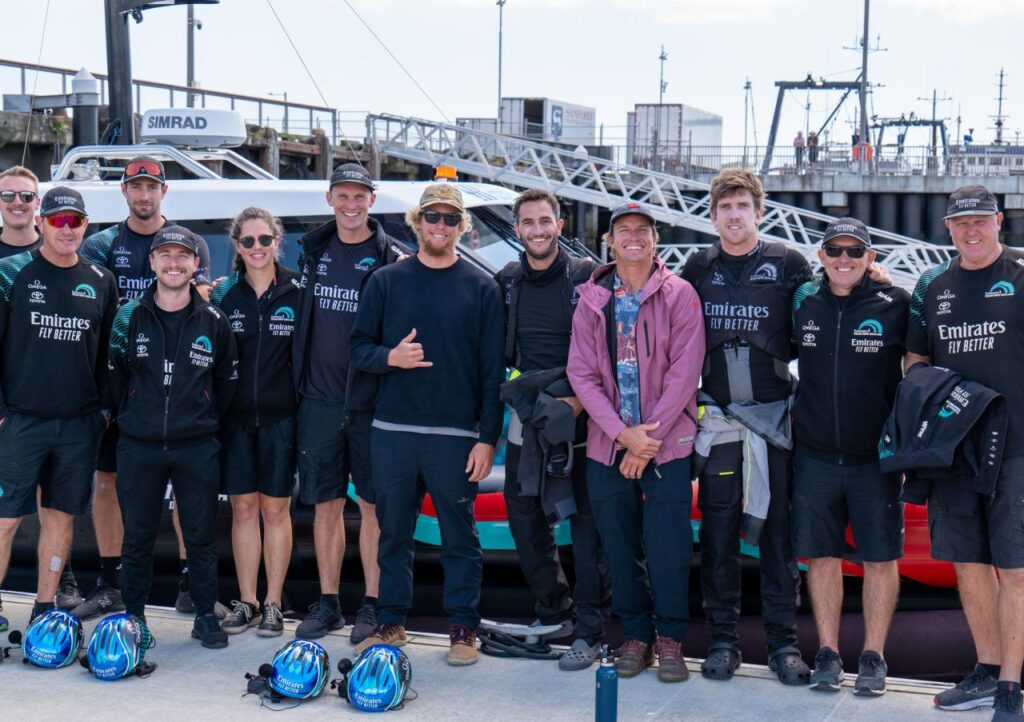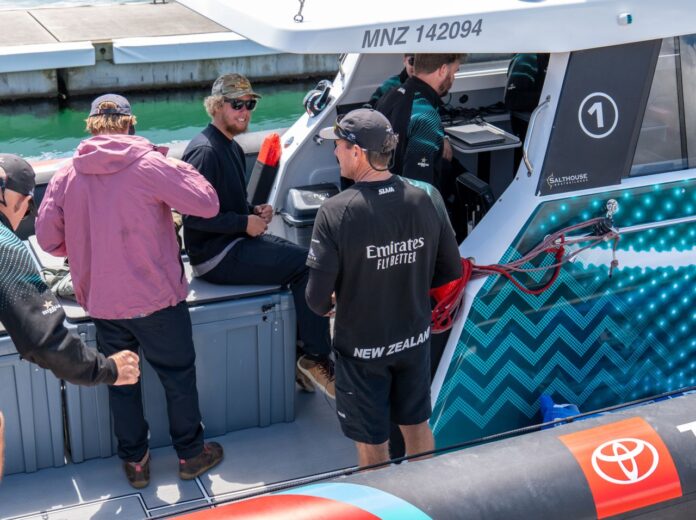The world of high-performance surfing met with the apex of America’s Cup foiling today down in New Zealand with Hawaiian-born surf legend and double winner of the Triple Crown of Surfing Champion, John John Florence hitching a rare ride at the end of the day on the Emirates Team New Zealand LEQ12 moded AC40 at the end of a glamour training and testing session out on the Hauraki Gulf.

With blue skies, sunshine, billiard-table flat water and an initial breeze of just 8-10 knots, it was a down-range start for the Kiwis, conditions that they’ve proven both in the AC40s and the AC75 to be masters in. On the new foils (Wing 02 and Wing 03), flight was easily attainable but Pete Burling and Nathan Outteridge were working hard through the tacks and gybes to maintain flight.

Watching the tacks from astern and in particular the wake, what we can see is an immediate dial away post tack as the helms drive onto the new foil aggressively to get the flow attachment with the mode of the boat just slightly heeled to leeward. Once comfortable, the cant is increased and the windward heel induced which brings the boat back to proper course leaving a curved wake astern. Upwind there was the usual trade-off between leeway and speed with the Kiwis favouring the windward-heel, International Moth style leeway reduction and only bringing the mode vertical through the lulls. Mesmeric to watch.

Conversely downwind, the helms were dialling up aggressively in the immediate aftermath of the gybes with the trimmers keeping the mainsail arced to windward on the traveller and a heap of camber in the sail to keep the power on.

Interestingly and caught on video was the reliance on just the mainsheet tension to close the leech and de-power and re-power whilst traveller movement could be measured in mere inches at a time in the lighter stuff. With the AC40 it’s all about power retention and having an innate feel for the boat’s mode, something that Blair Tuke and Andy Maloney are arguably the best in the world at sensing. Also of note was the ride height downwind as the team tested the foils with low cant. We don’t often see AC40s at that height for that long and although it perhaps didn’t look the fastest and is unlikely to be seen in race scenarios, it was an interesting exercise of rudder immersion on the limit and the new short-span Wing 03 earning its keep. Impressive sailing.

The manoeuvre count was particularly high today with in excess of 40 tacks and 35 gybes and although not their best foil-to-foil ratio ever recorded due to the lighter airs at the beginning, by the time the breeze filled in to 12 knots, that ratio rocketed. A total session time dock to dock today of some three hours, it was a great way to end what has been a productive week for the Kiwis back on their home waters and deep into technology analysis now ahead of the next stop in Jeddah, Saudi Arabia at the end of the month.
Blair Tuke summed up the day and the week as well as the importance of the development programme saying: “A glamour end of our first week back into it here in Aotearoa and yeah couldn’t have asked for much more, Friday afternoon sailing back into the harbour there with all the people starting to get out for the weekend, so pretty epic. The boat’s going nicely, it’s been a while since we’ve sailed in this configuration so it’s been a good week and another good one today…It’s always an exciting part of the campaign when you put these new foils in the water, this week’s been really interesting, it’s been performing well, as a crew we’ve been getting better as the week’s go on, bit of rust there from a control point of view early on, but yeah we’re getting there, just learning a lot around both the foils still, the other one is still relatively new as well for us, so yeah, learning a lot.”

Talking about the specifics of sailing in down-range conditions, Blair added: “It’s always the same whether you’re in the configuration we’re in here or one-design in the bottom end of the conditions it’s hard to make those manoeuvres stick, these boats are so efficient when they’re up and foiling it looks pretty easy but then to get through the manoeuvres is quite challenging and then if you touch down it’s hard to take off again. So, the name of the game is just try and keep it in the air and yeah I mean we had to work quite hard at times at it today and, as always, seeing different situations and how those foils reacted is important for us as we look to ultimately the race foils that are not too far away. So yeah, it’s an important time for us.”

This block of testing is slated through to the 24th November on the recon calendar and it will be interesting to see what new tech will be introduced over the coming weeks. As Blair Tuke says, this really is a very important fortnight for Emirates Team New Zealand. (Magnus Wheatley)

On-Water Recon Report – Emirates Team New Zealand: Day 40 for Emirates Team New Zealand out on the LEQ12. Another amazing day out on the Hauraki Gulf however with a different wind direction to the rest of the week.
Breeze started off light around 8 knots and ENE before slowly building through the day and tending North eventually peaking around 12 knots. The session started with a 12 o’clock dock out, before hoisting the M2 and J2 out in front of the base and hooking up a tow to foil towards North Head. Here the team cut the tow and attempted a couple of manoeuvres, however soon realised it was still too light.
Another tow was needed to get up on the foils and the team sailed upwind a short distance before discovering accelerating pressure through the Motuihe channel and around the bottom of Rangitoto. The team successfully completed all but a few foiling tacks, beating all the way upwind out towards Rakino Island before stopping for a short lunch break. A lot of the focus was put on practicing light wind tacks in the marginal wind range. While a high percentage of the tacks were full foilers, the team were suffering huge VMG losses trying to catch and keep speed out of the tacks, on both foils, especially the port foil as to be expected.
After a quick lunch, the team continued to sail upwind towards Tiritiri Matangi Island further North. Slowly the sea-state, which was previously very flat, started to build to around 0.4m and the team decided to bear away and sail a long downwind on the West side of Rangitoto. The team practiced many light wind gybes with the vast majority being successful. Again, in the lulls the VMG losses were noticeable with huge turn-ups and mainsail catches to try and keep the yacht on the foils. In the puffs however, the gybes were looking clean and smooth. The difference between 8 knots and 10 knots wind speed being very noticeable.
The team continued sailing down to Rangitoto Light House before making another stop at 1425. Here they took off Andy Maloney and quickly briefed and trained up a surfing legend and special guest, John John Florence. He took over the flight control position and did so quite well!
The team basically gybed their way straight back to the base with John John on board which included a nice long blast reach back up the inner harbour with speeds which looked to exceed 40 knots. The team dropped sails at 1500 and were back on the dock within 10 minutes before eventually lifting out at 1530 after another successful day on the water. Today we had a chance to speak with Flight Controller Blair Tuke after sailing for the interview, and he gave us a feeling of how the new foil has been going so far.
Follow us on X at @NauticMag for the freshest nautical news, insights, and more.






